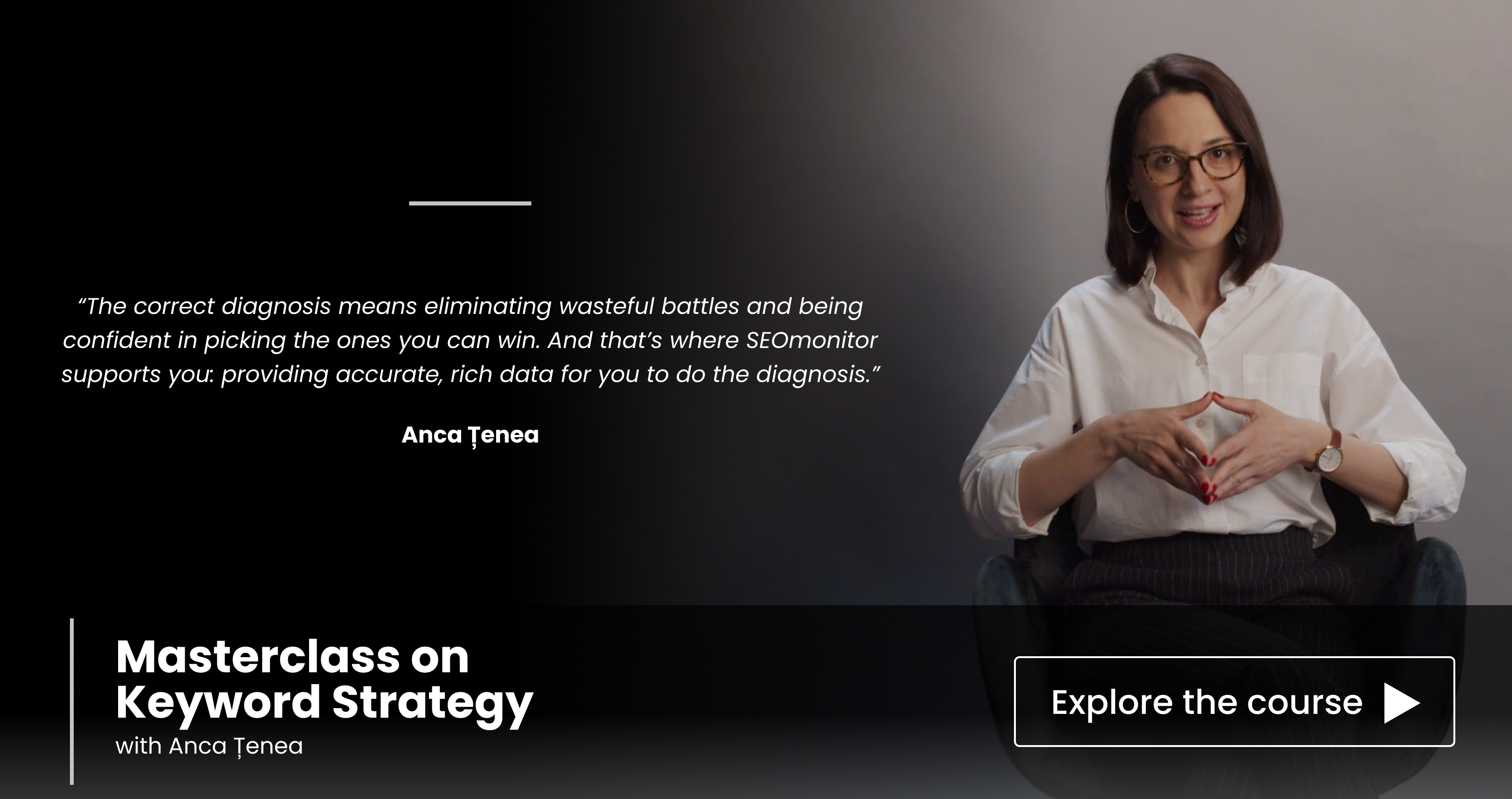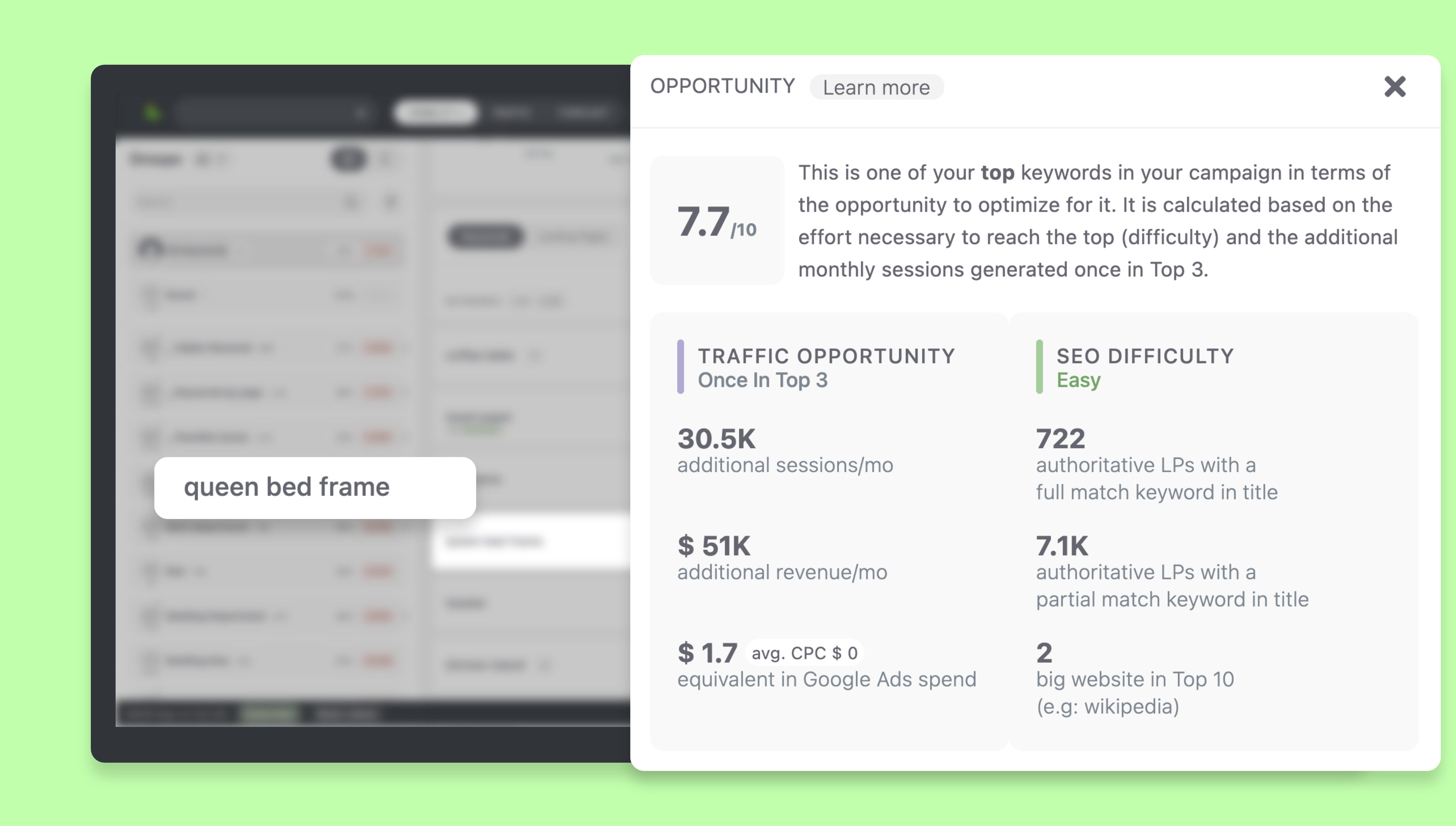As an SEO agency, you already know how important keyword research is.
Keyword research helps you understand the business opportunities of your clients and how to gather hundreds (or even thousands) of keywords for your SEO campaign.
But how do you go from a large list of keywords to an articulated, coherent, data-driven set that ensures you’ve zeroed in on the objective and know where you’re heading?
Jumping straight to execution – crunching tactics and tasks – might work in the short term. But without a well-defined strategy in place, the risk of wasting client resources and, ultimately, trust is high.
And you’ll know a strategy is good when you trust it to leverage your performance and generate results for your clients while ticking all the following boxes:
- Having a diagnosis which details the challenge to be solved. This helps you narrow your focus to a clear, simple problem that your client faces.
- Deciding on a guiding policy that defines the approach you follow for solving the problem.
- Developing a set of coherent actions: the tactics you’ll use, step by step, in accordance with your approach to get the best results and solve the problem.
This logical structure, called the kernel of strategy, can help your SEO agency at every stage of campaign development.
Read on to learn how to refine the guiding policy by avoiding common keyword strategy pitfalls.
Let’s go through them one by one, so you can discover new ways to get the most out of your keyword list and set yourself up for success.
One crucial pitfall you can encounter when curating your keyword list is not to account for the relevance of each keyword included.
Pitfall #1: You Include Branded Keywords in the Mix
Branded organic traffic is not SEO traffic.
The navigational keywords related to your client’s website or to other websites (even competitors’) won’t be valuable for your SEO campaign, as you can’t directly influence them.
Plus, your client owns all the branded keywords and they’re using other channels to amplify them (marketing campaigns, advertising, paid search, etc.).
You don’t need rank tracking or SEO for that.
Mixing the two will muddle your data and will make your client’s position in the search landscape seem better than it actually is – which, in turn, will alter the strategy and your desired objectives.
Think about this extreme example: including “amazon” or “facebook” in your targeted keyword group. All the relevant metrics would be artificially inflated – imagine the search volume numbers jumping to hundreds of millions all of a sudden.
That’s why, when curating your initial keyword research, it’s important to define your brand keywords and group them separately. Or use a tool like SEOmonitor that automatically segments that for you and further identifies “brand of others” keywords, so you know to exclude them from your strategy and ulterior tracking.
Pitfall #2: You Don’t Take Into Account Relevance
One crucial pitfall you can encounter when curating your keyword list is not to account for the relevance of each keyword included. Relevance defines, in this case, the client’s website ability to satisfy the search intent.
Here’s one conclusive example. Let’s say “London” slipped into your keyword list when you have a client like “University of London”. What is the user actually searching for when typing “London”?
It’s a broad search, so Google will try to guess the intent and offer different answers on the first page, from travel articles to institutional websites or wiki entries.
A low relevance keyword will inflate your overall data with high search volumes without bringing any search value for your client. Even if you manage to rank there, which is quite difficult, it wouldn’t matter in terms of ROI.
That’s why you should identify and exclude them from your list. The big clients are especially prone to this, so take a closer look when optimizing your keywords for them.
To continue our University of London example, if you take a look at what the competitors are ranking for, there’s a big chance that “Oxford” or “Cambridge” are not in the Top 20 for “London”.
With SEOmonitor, once you correctly select your competitors, the algorithm is able to detect whether a potential low relevance keyword appears in Top 100 for any of them. If not, it’s clearly not a relevant keyword for either of you.
Pitfall #3: You Include Keywords With High SEO Difficulty
You can think about this category as the “impossible for now.”
These are relevant, but resource-hoarder keywords: they’ll require too much energy and time.
Looking at the interplay between the difficulty to rank in the top 10 positions and their potential, including the competition already there, it’s clear whether you should bother with them, at the moment.
For instance, a newly launched fashion retailer might want to target “black dresses”, but they need to fight giants like H&M or ASOS.
Passing the keyword through a difficulty metric system would probably indicate it’s a hard endeavor and it would be a waste of resources to compete there now.
But after a few years, if the fashion retailer is highly specialized in “short cocktail dresses” and becomes established on the market, chances are it can outrank its big competitors and the SEO difficulty metric would indicate it’s an achievable feat.
Pitfall #4: You Don’t Mark Highly Localized Keywords
The problem with these keywords appears when you track keywords at a country or regional level.
This is because the search volume aggregates all the locations in there, while the rank only expresses a fraction of what the users performing those searches actually see – the result associated with a single location.
So you might end up thinking you’re accessing the whole search volume, but you’re not.
“Restaurants near me” is a great example here. When you optimize for such a highly localized keyword, you should think about it in terms of one keyword, one landing page, one location, which will imply different SEO tactics.
So be aware of these keywords in a broader market and group them accordingly.
Pitfall #5: You Include Tanking Keywords in Your Target List
This pitfall is a tricky one, so it’s important to spot it as quickly as possible. Tanking keywords are keywords with a significantly decreased search volume over the past 12 months, but which keep looking great as an average.
Here’s one quick example. In 2020, the search for “how to cut your hair” spiked as people were adapting to the lockdown. That spring spike completely vanished in 2021.
Keeping it in an SEO strategy would have been a mistake.
It’s a classic case of the average fallacy.
Look at year-over-year search trends to refine your list. Understanding current trends for your client’s industry and how demand and consumer behaviors shift is key in saving your resources and future performance.
In a Nutshell
Keyword research is just the input for a well-rounded keyword strategy that helps you keep away from wasting your agency and your client’s resources, time, and ultimately trust.
But to make the journey from a huge list of keywords to a strategic selection implies looking at the bigger picture and identifying what needs to happen and what needs to be avoided.
In terms of keyword strategy pitfalls, that includes:
- No branded keywords mixed with the non-brand ones.
- Paying attention to low-relevance keywords that might infiltrate your list and skew your overall data, without creating value for your clients.
- Excluding keywords with high SEO difficulty for now – you might return to them after you’ve grown your client’s website.
- Spotting the highly localized keywords, so you don’t mix their whole search volume with a ranking for one location.
- Looking at year-over-year search trends and quickly spot a tanking keyword.
These are just a few of the common pitfalls we identified as part of SEOmonitor Masterclass on Keyword Strategy. If you want to further explore this lesson and many others designed just for SEO agencies, then you can enroll for free and discover how to refine a keyword strategy or use forecasting for better SEO proposals.
Our masterclasses include assignments, key takeaways, case studies, and demos for agencies to study and use in their own processes. After completing them you’ll be able to leverage strategic frameworks for your agency and make better decisions for your future SEO campaigns.
Join our learning community today and help us bring more transparency to the SEO industry!
Discover actionable strategic frameworks for SEO agencies
The opinions expressed in this article are the sponsor's own.






